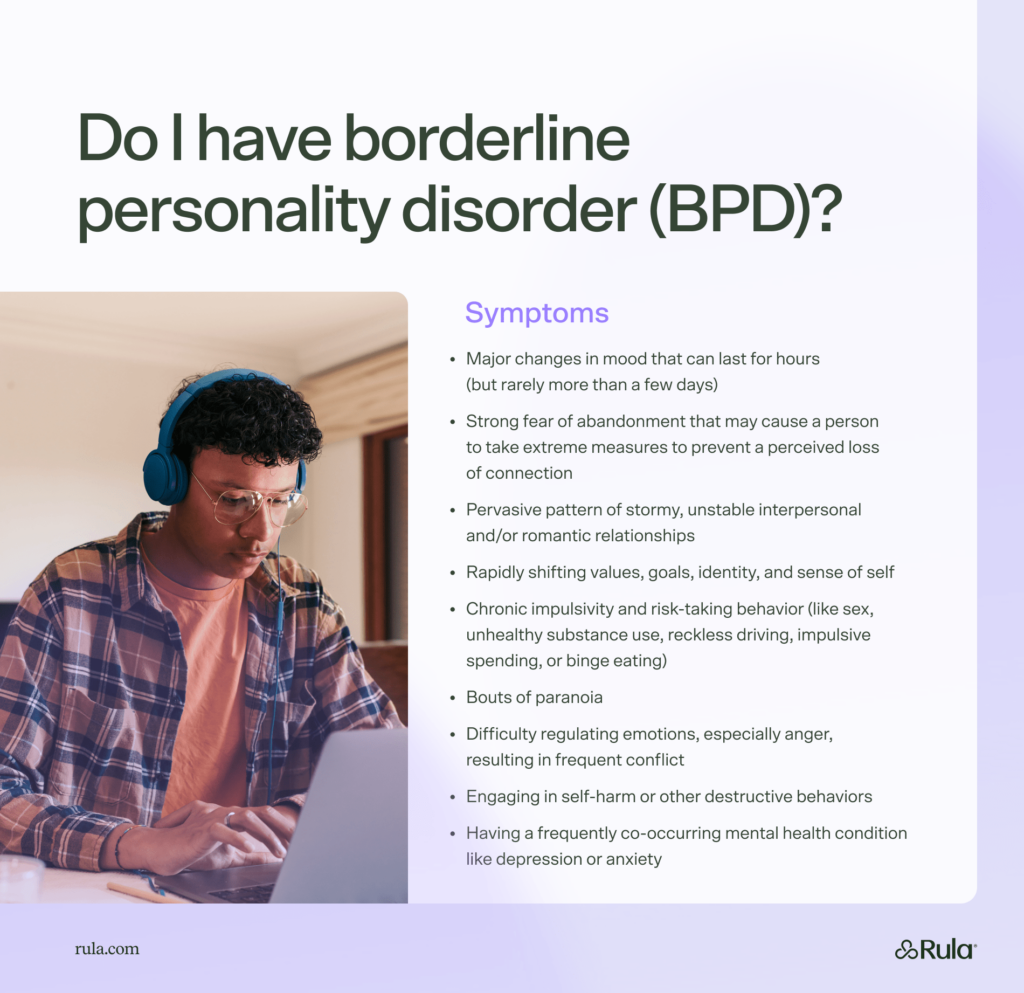Key Takeaways
Borderline personality disorder (BPD) is a mental health condition that can impact your thoughts, feelings, behaviors, and sense of self.
People living with BPD may experience intense mood swings, chronic instability, a deep fear of abandonment, and difficulty maintaining relationships. BPD can lead to impulsivity and high-risk behavior that could compromise a person’s safety.
If you’re concerned that you might be experiencing signs of BPD, taking a BPD self-assessment can help you increase your self-awareness and know when to seek support.
Borderline personality disorder (BPD) is a mental health condition that affects the way you think, feel, and connect with other people. It often comes with intense emotions, ups and downs in relationships, and a shaky sense of who you are. If you’ve ever wondered how to tell if you might have BPD, some common signs include big mood swings, a strong fear of being abandoned, impulsive decisions, and trouble managing anger or self-worth.
Only about 2% of adults in the U.S. are diagnosed with BPD, according to the National Alliance on Mental Illness. Around 75% of those diagnosed are women, but research shows that many men with similar symptoms are often misdiagnosed with other conditions like depression or post-traumatic stress disorder (PTSD). BPD can take a toll on relationships and daily life, but with the right support and treatment, it’s absolutely possible to find balance, build healthy connections, and live a full, meaningful life.
Taking an online BPD test won’t give you a diagnosis — but it can help you notice patterns in how you think, feel, and relate to others. Your quiz results can give you a better sense of whether you might be experiencing symptoms of borderline personality disorder (BPD) and help you decide if you’d like to seek support or a formal evaluation from a mental health professional.
What is BPD?
BPD is a mental health condition that requires a professional diagnosis. It is known to profoundly impact the way you see yourself and the way you relate to other people. BPD typically arises in early adulthood and often causes a deep fear of abandonment, impulsivity, extreme anger, impulsiveness, and frequent mood swings. Together, these symptoms can have a destabilizing effect that can make it difficult to function in daily life.
What are the symptoms of BPD?
BPD is a mental health condition that’s characterized by mood swings, impulsive behavior, and instability in relationships. While BPD can manifest in different ways, depending on the individual, there are some known signs and symptoms.
Major changes in mood that can last for hours (but rarely more than a few days)
Strong fear of abandonment that may cause a person to take extreme measures to prevent a perceived loss of connection
Pervasive pattern of stormy, unstable interpersonal and/or romantic relationships
Rapidly shifting values, goals, identity, and sense of self
Chronic impulsivity and risk-taking behavior (like sex, unhealthy substance use, reckless driving, impulsive spending, or binge eating)
Bouts of paranoia
Difficulty regulating emotions, especially anger, resulting in frequent conflict
Engaging in self-harm or other destructive behaviors
Having a frequently co-occurring mental health condition like anxiety or depression
Note: Without treatment, people living with BPD are at serious risk for self-injury and suicide. If you or someone you care about is in crisis, or you just need someone to talk to, contact the National Suicide and Crisis Lifeline by dialing 988 from any phone. This free, confidential resource provides 24/7 support.
What causes BPD?
Like other mental health disorders, the causes of BPD aren’t fully understood. But some research indicates that there are some genetic and environmental factors that might put you at a higher risk for developing the condition, including:
Problems with the way the brain regulates chemicals, specifically serotonin
Irregular development of certain parts of the brain
Surviving a traumatic childhood involving abuse or parental neglect
Growing up in a home where you witnessed a serious mental illness and/or substance misuse
Having a first-degree relative who also has BPD

BPD self-assessment test
These questions* are designed to help you reflect and notice possible signs of borderline personality disorder (BPD).
This self-check isn’t a diagnosis — only a qualified mental health professional can make that determination. But it can help you decide if seeking extra support or an evaluation might be helpful.
Do you often worry that people you care about might leave or abandon you?
Do your relationships tend to feel all-or-nothing — very close one moment and distant the next?
Do your emotions shift quickly, sometimes within hours or even minutes?
Do you act impulsively, such as spending too much, driving recklessly, or saying things you later regret?
Do you sometimes feel empty, numb, or disconnected from yourself?
Do you have challenges with anger that feels stronger than the situation calls for?
Do you often feel anxious, sad, or irritable and have trouble calming down?
Do you find it hard to trust others, or worry that people secretly don’t like you?
Do you sometimes feel unsure who you are or what you believe in?
When you’re stressed, do you ever feel detached from reality or suspicious of others?
If several of these experiences sound familiar, you may want to reach out to a licensed therapist or psychiatrist. With the right support — like dialectical behavior therapy (DBT) or other evidence-based treatments — people living with BPD can build emotional stability, strengthen relationships, and create a life that feels more balanced and fulfilling.
Quiz content written by Brandy Chalmers, LPC.
Interpreting your quiz results
It’s completely normal to answer “yes” to a few of these questions — everyone feels intense emotions or has relationship challenges sometimes. For example, you might have gone through a breakup that left you feeling abandoned, or had a day where your emotions felt like they were all over the place. These experiences alone don’t necessarily mean you have borderline personality disorder (BPD).
However, if you answered “yes” to many of these questions and notice that your emotions, relationships, or self-image are often hard to manage, it might be worth reaching out to a mental health professional. Only a licensed clinician can make a diagnosis, but talking with someone can help you better understand your experiences and explore next steps.
Remember, BPD is treatable. With the right support — like therapy, medication, or skills training — many people learn to manage their emotions, strengthen relationships, and build a more fulfilling life.
How do therapists test for BPD?
If you just took the BPD self-assessment, you might be wondering what it means and what comes next. While quizzes like this can help you notice patterns in how you think and feel, only a licensed mental health professional can make an official diagnosis.
There’s no blood test or brain scan for borderline personality disorder (BPD). Instead, providers use interviews, written assessments, and the Diagnostic and Statistical Manual of Mental Disorders (DSM-5) to see whether your symptoms fit the criteria for BPD.
During the evaluation, your therapist will ask about your emotions, relationships, and past experiences. They may want to know when your symptoms started, how long they last, and how they affect your daily life. You might also talk about things like fear of abandonment, mood swings, impulsive choices, or challenges with identity and self-worth.
Because BPD can overlap with other conditions like anxiety, depression, or post-traumatic stress disorder (PTSD), your therapist may work with you to rule out other causes. Once they have a full picture, they’ll work with you to build a treatment plan that helps you manage your emotions, strengthen relationships, and create more stability in your life.
Dig deeper:
Clinician's take
With the right support, you can learn to understand your emotions instead of being overwhelmed by them. Healing with BPD is absolutely possible.

Brandy Chalmers, LPC
Clinical reviewer
How Rula can help with BPD
If you think you may have BPD, it’s important to seek professional help as soon as possible. While the experience of living with BPD can be difficult, the right treatment can help you find relief and manage your symptoms.
Using Rula, you can quickly find a therapist who’s in-network with your insurance who treats BPD. Our platform is designed to take the confusion out of accessing treatment and make it easy to attend sessions virtually from the comfort of your home.
And since our teletherapy platform also includes psychiatric services, we can also connect you with a provider who can help you with medication management if that’s part of your care plan. To learn more about getting help for BPD with Rula, check out our website.
Trauma and PTSD therapists near you
New York, NY – Houston, TX – Rancho Cucamonga, CA – Austin, TX – Chicago, IL – Los Angeles, CA – Columbus, OH – Portland, OR – Dallas, TX – Jacksonville, FL – Charlotte, NC – Denver, CO – Huntsville, AL – Philadelphia, PA – Seattle, WA – Find your city